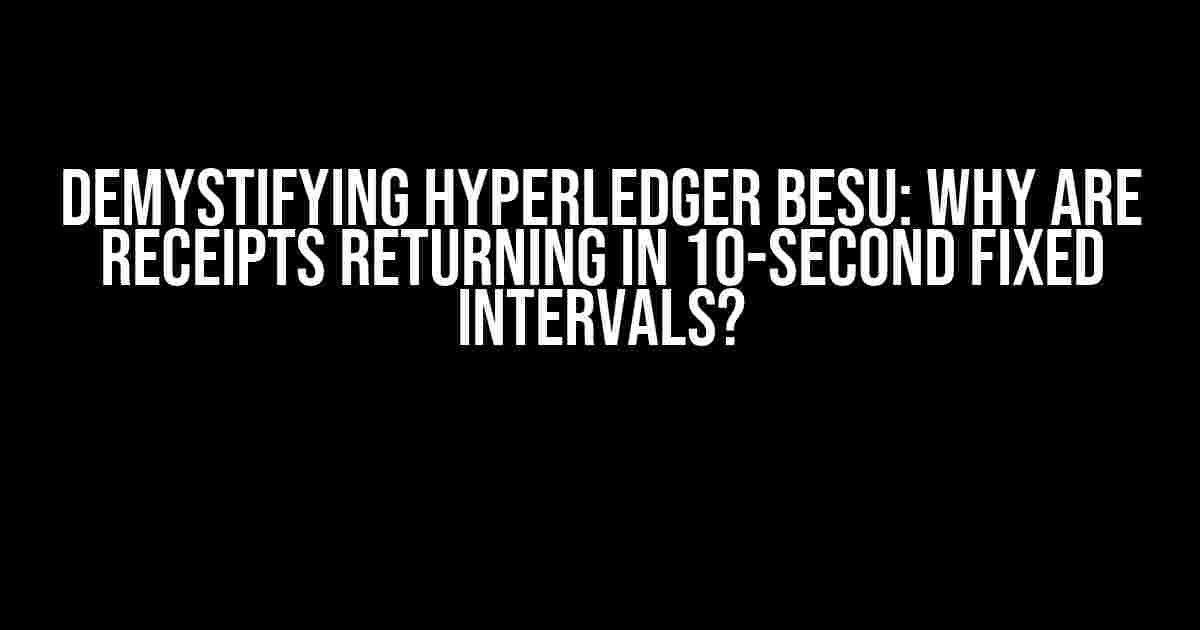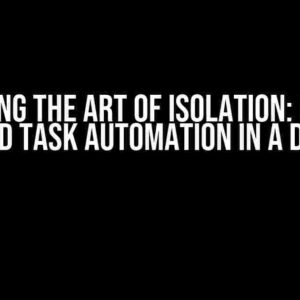Are you tired of wondering why Hyperledger Besu is returning receipts in 10-second fixed intervals? You’re not alone! In this article, we’ll delve into the world of Hyperledger Besu, exploring the reason behind this phenomenon and providing practical solutions to help you navigate this issue.
What is Hyperledger Besu?
Before we dive into the mystery of the 10-second fixed intervals, let’s take a step back and understand what Hyperledger Besu is. Hyperledger Besu is an Ethereum client designed for enterprise use cases, built on top of the Java Virtual Machine (JVM). It’s a popular choice for businesses and organizations looking to leverage blockchain technology due to its scalability, security, and ease of use.
The Receipt Return Conundrum
So, why are receipts returning in 10-second fixed intervals? To understand this, we need to explore how Hyperledger Besu handles transactions and receipts.
Transaction Processing and Receipt Generation
In Hyperledger Besu, when a transaction is sent to the network, it’s processed and verified by the nodes. Once verified, a receipt is generated, which contains information about the transaction, such as the transaction hash, block number, and gas used. This receipt is then returned to the sender, providing confirmation that the transaction has been successfully processed.
The Role of the Transaction Pool
The transaction pool is a crucial component in Hyperledger Besu’s transaction processing mechanism. It’s a buffer that stores transactions waiting to be processed and verified. When a transaction is sent to the network, it’s first added to the transaction pool. The pool is then scanned at regular intervals to identify transactions that are ready to be processed.
The 10-Second Interval: A Design Choice
So, why do receipts return in 10-second fixed intervals? The answer lies in the design choice made by the Hyperledger Besu developers. The transaction pool is scanned every 10 seconds to identify transactions that are ready to be processed. This scanning interval is hardcoded into the Besu codebase.
This design choice has several benefits:
- It allows for efficient processing of transactions, as the pool is scanned at regular intervals, ensuring that transactions are processed in a timely manner.
- It prevents the transaction pool from growing indefinitely, which could lead to performance issues and increased memory usage.
- It provides a consistent and predictable experience for users, as receipts are returned at fixed intervals.
Configuring the Scanning Interval
While the 10-second interval is hardcoded, it is possible to configure the scanning interval to suit your specific use case. This can be achieved by modifying the `besu.conf` file, which contains configuration settings for Hyperledger Besu.
transaction.pool.scan.interval=10
In this example, the scanning interval is set to 10 seconds. You can modify this value to increase or decrease the scanning interval, depending on your specific requirements.
Handling Receipts in Your Application
Now that you understand why receipts are returning in 10-second fixed intervals, let’s explore how to handle them in your application.
Using Web3j
If you’re using Web3j, a popular Java library for interacting with the Ethereum blockchain, you can use the following code snippet to handle receipts:
Web3j web3j = Web3j.build(new HttpService("https://your-besu-node.com"));
TransactionReceiptProcessor receiptProcessor = new TransactionReceiptProcessor(web3j);
receiptProcessor.pollForReceipts();
This code snippet creates a Web3j instance and uses the `TransactionReceiptProcessor` class to poll for receipts at regular intervals.
Using Besu’s REST API
If you’re using Besu’s REST API, you can use the following endpoint to retrieve receipts:
GET /eth/v1/transactions/{txHash}/receipt
This endpoint returns the receipt for a specific transaction hash. You can use this endpoint to poll for receipts at regular intervals, using the 10-second scanning interval as a guideline.
Best Practices for Handling Receipts
When handling receipts in your application, it’s essential to follow best practices to ensure efficient and reliable processing:
Polling Intervals
When polling for receipts, it’s essential to respect the 10-second scanning interval. Polling too frequently can lead to increased load on your Besu node, while polling too infrequently can result in delayed receipt processing.
Error Handling
When processing receipts, it’s essential to handle errors and exceptions gracefully. This includes handling cases where receipts are not returned, or where errors occur during processing.
Receipt Storage
When storing receipts, it’s essential to consider storage costs and scalability. Consider using a scalable storage solution, such as a database or message queue, to store receipts.
Conclusion
In this article, we’ve demystified the reason behind Hyperledger Besu’s 10-second fixed interval for returning receipts. We’ve explored the transaction processing mechanism, the role of the transaction pool, and the design choice behind the scanning interval. We’ve also provided practical solutions for configuring the scanning interval, handling receipts in your application, and following best practices for efficient and reliable processing.
By understanding the intricacies of Hyperledger Besu’s receipt return mechanism, you can build more efficient and scalable applications that leverage the power of blockchain technology.
| Topic | Description |
|---|---|
| Hyperledger Besu | A Java-based Ethereum client designed for enterprise use cases |
| Transaction Pool | A buffer that stores transactions waiting to be processed and verified |
| Scanning Interval | The regular interval at which the transaction pool is scanned for transactions ready to be processed (hardcoded to 10 seconds) |
| Receipt | A confirmation returned to the sender, providing information about the transaction |
If you have any further questions or need help with implementing Hyperledger Besu in your application, feel free to ask!
Happy building!
Frequently Asked Question
Get ready to dive into the world of Hyperledger Besu and uncover the mysteries behind its receipt returning in 10 seconds fixed intervals!
Why does Hyperledger Besu receipt return in 10 seconds fixed intervals?
This is because Hyperledger Besu is designed to prioritize responsiveness and fairness in its transaction processing. By returning receipts in fixed 10-second intervals, Besu ensures that nodes can efficiently process and propagate transactions, maintaining a consistent and predictable network performance.
What’s the reasoning behind choosing 10 seconds specifically?
The 10-second interval is a deliberate design choice, striking a balance between responsiveness and fairness. It allows nodes to process a sufficient number of transactions while preventing overwhelming the network with too many simultaneous requests. This interval also provides a comfortable buffer for nodes to adapt to changes in network conditions.
Can I adjust the 10-second interval to better suit my application’s needs?
While it’s technically possible to tweak the interval, it’s not recommended. Changing the interval could potentially disrupt the network’s performance and fairness guarantees. Instead, consider optimizing your application’s transaction processing and batching strategies to work in harmony with Besu’s design.
How does this fixed interval impact the overall scalability of Hyperledger Besu?
The 10-second interval is a trade-off between responsiveness and scalability. While it may limit the network’s maximum throughput, it ensures that Besu can maintain a consistent and predictable performance, even under high loads. To achieve better scalability, focus on optimizing your application’s usage patterns and leveraging Besu’s built-in features, such as parallel transaction processing.
Are there any plans to adjust or remove the 10-second interval in future Besu releases?
The Besu development team continuously monitors performance and user feedback. While there are no immediate plans to change the interval, future releases may introduce new features or optimizations that could impact the receipt returning mechanism. Stay tuned to the Besu community and roadmap for updates!


